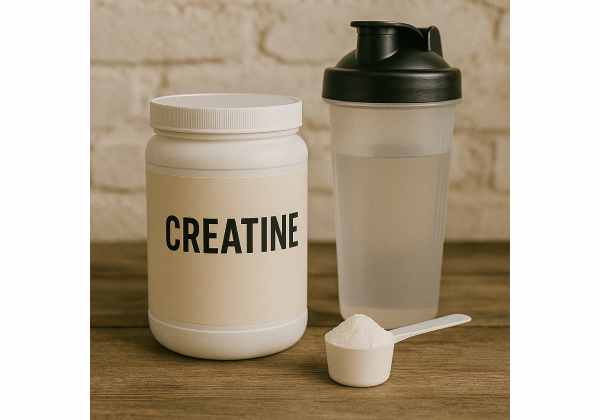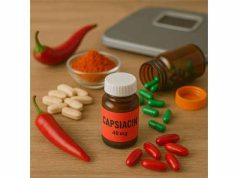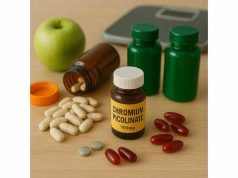Creatine is often labeled a “bulking” supplement, yet it may be most valuable when you are cutting. During a calorie deficit, your body fights to shed fat but also lets go of muscle and training performance. Creatine helps you lift heavier, complete more reps, and recover better—so a larger share of your weight loss comes from fat, not lean tissue. It does not melt fat directly or override a poor diet. It is a performance and muscle-preservation tool. In this guide, you will learn how to use creatine during weight loss, what the early “water weight” really is, realistic results, and who should avoid it. If you are comparing supplements with medical options, start with our plain-language overview of evidence-based medical and supplement tools for weight management.
Table of Contents
- Does creatine help during weight loss?
- Dose, loading and timing while cutting
- Water weight: what changes and why
- Muscle retention and training performance
- Common mistakes and how to fix them
- Safety, interactions and who should avoid creatine
- What results to expect in 12 weeks
- Frequently asked questions
Does creatine help during weight loss?
Short answer: Yes—creatine supports better training, lean mass retention, and higher work capacity during a calorie deficit. That translates to a higher percentage of weight lost from fat, fewer performance drop-offs, and a less “flat” look. Creatine does not increase fat loss directly; it enables the habits that protect muscle while you lose fat.
Why creatine matters in a cut
- Protects lean mass: Dieting lowers muscle protein synthesis and training quality. Creatine raises intramuscular phosphocreatine, so you can maintain loading and volume—the main stimulus that keeps muscle.
- Supports performance: Expect small but meaningful boosts in reps completed, bar speed, and sprint repeatability. Over weeks, that compounding effect preserves strength.
- Improves training tolerance: Slightly better recovery between sets lets you keep rest periods and work density consistent while calories are reduced.
- Body composition impact: Because more of the lost weight is fat, your waist and skinfolds tend to improve even if the scale is occasionally noisy.
What creatine does not do
- It does not “dry you out” or “bloat” you in the way sodium does. Early weight gain is intramuscular water, not subcutaneous puffiness.
- It does not replace dietary structure, steps, sleep, or protein. Without those, creatine is underpowered.
- It does not override a large calorie surplus. Energy balance still rules.
How creatine fits with the rest of your plan
Keep the fundamentals front and center: protein 1.2–1.6 g/kg/day, fiber 25–35 g/day, two to three full-body strength sessions weekly, and consistent sleep. If you are still setting those basics, skim our core guidance on safe, sustainable weight loss to anchor your approach before layering creatine.
Who notices the biggest benefit
- People who lift 2–4 times per week with progressive overload.
- Dieters who want to prevent the common 2–4% drop in strength during a cut.
- Older adults and women—groups that often benefit from the muscle-preserving effects when calories are reduced.
Dose, loading and timing while cutting
You can load creatine quickly or reach the same muscle saturation slowly. Choose the method that fits your stomach and schedule.
Two effective ways to start
- No-load method (simplest): Take 3–5 g creatine monohydrate once daily, any time of day, with or without food. Muscles reach saturation in 3–4 weeks.
- Loading method (faster): Take 20 g/day split into 4 × 5 g doses for 5–7 days, then 3–5 g/day. This saturates muscles in about a week but can cause more GI upset. If your stomach is sensitive, skip loading.
Form matters less than dose
- Creatine monohydrate is the gold standard: proven, inexpensive, and as effective as fancier forms. Micronized monohydrate mixes easier and may be gentler on the stomach.
- Creatine hydrochloride and buffered versions are more expensive with no consistent advantage for outcomes at matched creatine doses.
Timing tips
- Consistency beats timing. If you like routines, take creatine with your first meal or post-workout so you never forget.
- Taking it with a carb and protein meal (e.g., yogurt and fruit or a post-lift shake) may reduce GI discomfort and support uptake, but it is not mandatory.
- If caffeine is part of your pre-workout, keep it; creatine and caffeine can coexist. Watch sleep timing and total caffeine load.
How to read the label
- Check that the serving lists at least 3 g creatine monohydrate (or 5 g if loading).
- Avoid blends that hide the dose inside “proprietary” matrices.
- Look for transparent dosing and (ideally) third-party testing. If label reading is new, our quick primer on decoding supplement labels will help you verify the real daily amount.
Mixing and storage
- Mix with water, juice, or your shake. Solubility improves in warm liquids.
- Store dry and sealed. Creatine is stable at room temperature; no need to refrigerate.
Water weight: what changes and why
Creatine pulls water into muscle cells as phosphocreatine stores expand. That increase is intracellular—inside muscle—where you want it. The scale may bump up 0.5–1.5 kg (1–3 lb) in the first weeks, especially if you loaded. This is not fat gain and does not hide fat loss.
What to expect in week 1–3
- Scale: A small uptick or plateau despite a calorie deficit.
- Mirror: Muscles may look fuller, not smoother, especially in trained limbs.
- Waist and clothes: Typically unchanged—use these as your early “truth meters.”
Why the scale blips but the waist does not
- Water added inside muscle supports performance and glycogen storage. It does not sit under the skin (subcutaneous) where “bloat” shows up visually.
- As fat loss accumulates, the waistline trend and progress photos reveal progress even when the weekly average weight is noisy.
How to track progress without frustration
- Use weekly averages instead of single weigh-ins. Weigh at the same time each morning (after bathroom, before breakfast) and average 5–7 readings.
- Track waist circumference at the navel and hip weekly.
- Keep a simple training log (sets, reps, loads) to confirm creatine’s benefit.
Creatine and glycogen
- Creatine can indirectly support higher glycogen by allowing quality training. Glycogen also stores water (about 3 g water per gram), which adds to the full, trained look.
- Do not chase dehydration to “look tighter.” That sacrifices performance and can impair fat loss via worse training.
Pairing with practical nutrition
- Keep protein high and include soluble fiber (beans, oats, psyllium) for appetite control. If breakfast is tough during a cut, a shake can help; see fast options in our guide to using protein shakes during weight loss.
Muscle retention and training performance
Creatine’s main value while cutting is keeping training quality high. The better you train, the more your body gets the message to keep muscle and burn fat.
What improves with creatine
- Volume: Slight increases in total reps or weight moved across a session.
- Power and sprint repeatability: Better performance in short, repeated efforts (sprints, prowler pushes, rowing intervals).
- Recovery between sets: Shorter rest needed for the same output or more output at the same rest.
Program design during a cut
- Frequency: Lift 2–4 days/week, emphasizing compound patterns (squat/hinge, push, pull).
- Intensity and volume: Keep loads moderate to heavy (≈70–85% 1RM), with 2–4 working sets per lift. Add a little volume when you feel strong; do not chase failure every set.
- Cardio: Add zone-2 sessions (easy pace you can speak in full sentences) for recovery and health. Keep HIIT brief and purposeful.
- Progression: Use double progression: when you hit the top of your rep range across sets with solid form, add a small amount of weight next time.
Protein and creatine synergy
- Protein at 0.6–0.8 g/lb (1.2–1.6 g/kg) supports muscle protein synthesis; creatine ensures you train hard enough to use it.
- Distribute protein across 3–4 meals with 25–40 g each. Older adults benefit from the higher end per meal.
Performance add-ons that actually help
- Caffeine 30–60 minutes pre-workout can raise power output and perceived energy—especially useful in a deficit. Use it wisely and avoid late-day doses that impair sleep. See dosing and timing considerations in our guide to caffeine for weight loss and training.
What results feel like
- Sets that previously stalled at 8 reps now hit 9–10 with clean form.
- Strength holds steady for longer weeks into the cut.
- You finish sessions feeling trained, not drained—key for consistency.
Common mistakes and how to fix them
Creatine is simple, but cutting adds moving parts. These are the errors that blunt results—and how to correct them fast.
1) Loading too aggressively
- Problem: 20 g/day on day one with minimal water leads to GI upset.
- Fix: Use the no-load 3–5 g/day plan, or split loading into 4 × 5 g with meals and ample fluids.
2) Under-eating protein
- Problem: Appetite suppression during a cut pushes protein too low; strength fades.
- Fix: Set non-negotiables: 25–40 g protein per meal, 3–4 meals/day. Keep easy options on hand (eggs, Greek yogurt, canned fish, precooked chicken, plant proteins).
3) Chasing “dryness”
- Problem: Cutting water or sodium to chase the scale makes training suffer and worsens recovery.
- Fix: Hydrate normally. Expect a small intramuscular water gain with creatine; it is productive.
4) Skipping progressive overload
- Problem: Same weights, same reps, shrinking muscles.
- Fix: Use a log. Aim to add one rep or 2–5% load somewhere each week or two, then rotate movements if joints complain.
5) Buying flashy blends
- Problem: Proprietary formulas under-dose creatine and over-dose fillers.
- Fix: Choose plain creatine monohydrate with disclosed grams per scoop and (ideally) third-party certification. See what logos and testing mean in our quick guide to independent testing.
6) Overdoing stimulants
- Problem: High-stim pre-workouts plus diet stress wreck sleep—fat loss and recovery stall.
- Fix: Cap caffeine, avoid evening doses, and keep sleep 7–9 hours. Creatine works without stimulants.
7) Expecting creatine to burn fat
- Problem: Looking for a scale drop from creatine itself.
- Fix: Treat creatine as a muscle-preservation tool. Fat loss comes from a stable calorie deficit and consistent training.
Safety, interactions and who should avoid creatine
Creatine is among the most studied sports supplements and is well-tolerated in healthy adults when used as directed. Still, there are caveats.
Common, mild effects
- GI discomfort (especially with rapid loading or taking on an empty stomach).
- Early scale increase from intramuscular water.
- Benign rise in serum creatinine—a lab artifact from higher creatine turnover—not the same as reduced kidney function. Clinicians often interpret it alongside cystatin-C or eGFR trends.
Who should avoid or get medical clearance
- Chronic kidney disease, significant single-kidney status, or a history of recurrent acute kidney issues—seek personalized guidance.
- Pregnancy or breastfeeding: evidence is limited; most experts recommend avoiding supplemental creatine.
- Active liver disease or complex polypharmacy: discuss with your clinician first.
- Adolescents: Creatine can be appropriate for some teen athletes with professional supervision; for weight loss, focus on nutrition and coaching instead.
Hydration and electrolytes
- Drink to thirst and a bit beyond during heavy training or heat. Creatine does not require extreme water loading; normal hydration is enough.
Medication and supplement stacking
- No known dangerous interactions at typical doses in healthy adults, but use caution with nephrotoxic medications or dehydration-prone regimens.
- Be selective with add-ons. Skip multi-stimulant “fat burners”—they add risk without better outcomes. For a reality check on those blends, see why most “fat burners” are not worth it.
Quality and contamination
- Choose products with transparent dosing and, when possible, third-party certifications (USP, NSF, Informed Choice). Avoid “kitchen sink” proprietary blends.
Stop rules
- Persistent GI issues despite dose splitting, signs of dehydration, or any unexplained drop in eGFR or concerning symptoms—stop and consult your clinician.
What results to expect in 12 weeks
A realistic 12-week cut with creatine focuses on body composition and performance, not just scale weight. Here is a practical template and the outcomes many lifters see.
Weeks 1–2: Saturation and setup
- Start 3–5 g/day creatine monohydrate.
- Set protein at 1.2–1.6 g/kg/day; spread across 3–4 meals.
- Train 3 days/week full body; add two easy cardio sessions.
- Expect the scale to hold or tick up slightly; waist often steady.
Weeks 3–6: Performance holds while fat loss starts to show
- Strength lifts hold or creep up 1–2% despite the deficit.
- Weekly average weight trends down 0.3–0.7% of body weight; waist drops 0.5–1.5 cm.
- Muscles look fuller in photos even as fat decreases.
Weeks 7–12: Compounding effects
- Better training density → more calories burned without extra hunger.
- Many report smaller losses of lean mass compared with prior cuts (sometimes even slight gains at stable strength).
- The main visual changes are at the midsection and back, where fat tends to leave next as training quality stays high.
Metrics that matter
- Waist and hip every week.
- Strength log (e.g., top set and back-off sets).
- Weekly weight average (not single days).
- Sleep and step counts to catch drift early.
Case-style expectations (illustrative)
- A 80 kg lifter on a structured deficit with creatine may drop 4–6 kg across 12 weeks, with waist −4–7 cm, while main lifts stay within 2–3% of baseline. Without creatine and progressive overload, the same person might lose similar scale weight with more lean mass lost and larger strength declines.
When creatine will not move the needle
- Training is irregular, protein is low, or sleep is poor. Creatine amplifies the inputs you give it; it is not a substitute for them.
Frequently asked questions
Will creatine make me gain fat while cutting?
No. Early scale increases are intramuscular water, not fat. Fat loss still follows your calorie deficit and activity. Use waist measurements, photos, and weekly weight averages to see through short-term noise.
Should I load creatine or just take a daily dose?
Both work. Loading (20 g/day for 5–7 days) saturates muscles faster but can upset your stomach. Taking 3–5 g/day without loading reaches the same saturation in 3–4 weeks and is easier during a cut.
What type of creatine is best for weight loss phases?
Plain creatine monohydrate. It is the most studied, effective, and cost-efficient form. Micronized monohydrate mixes better. Fancier forms have not shown superior results at matched creatine doses.
Can I take creatine with caffeine?
Yes. Many lifters use both, especially pre-workout. Keep total caffeine appropriate for your sleep schedule. Caffeine helps perceived effort and power; creatine supports repeated efforts and training volume.
How much water should I drink on creatine?
Hydrate normally and a bit more around hard training. There is no need to “force gallons.” The water shift with creatine is inside muscle, not subcutaneous bloat.
Is creatine safe for women and older adults?
Yes for healthy individuals. Women and older adults often see notable performance and muscle-retention benefits during weight loss. As with anyone, those with kidney disease or complex medical histories should consult their clinician first.
References
- The Effects of Creatine Supplementation Combined with Resistance Training on Regional Measures of Muscle Hypertrophy: A Systematic Review with Meta-Analysis 2023 (Systematic Review)
- Effects of Creatine Supplementation and Resistance Training on Muscle Strength Gains in Adults <50 Years of Age: A Systematic Review and Meta-Analysis 2024 (Systematic Review)
- A Randomized Controlled Trial of Changes in Fluid Distribution across Menstrual Phases with Creatine Supplementation 2023 (RCT)
- Is It Time for a Requiem for Creatine Supplementation-Induced Kidney Failure? A Narrative Review 2023 (Safety Review)
- International Society of Sports Nutrition position stand: safety and efficacy of creatine supplementation in exercise, sport, and medicine 2017 (Guideline)
Disclaimer
This article is educational and does not replace personalized medical advice, diagnosis, or treatment. Always speak with your healthcare professional before starting, stopping, or combining supplements—especially if you have kidney or liver disease, are pregnant or breastfeeding, or take prescription medications.
Share and follow
If this guide clarified how creatine supports muscle while you lose fat, consider sharing it with a friend who lifts during a cut. For steady, evidence-based updates on weight, nutrition, and training, follow us on the social platforms you use most—Facebook, X, Instagram, or LinkedIn.

















